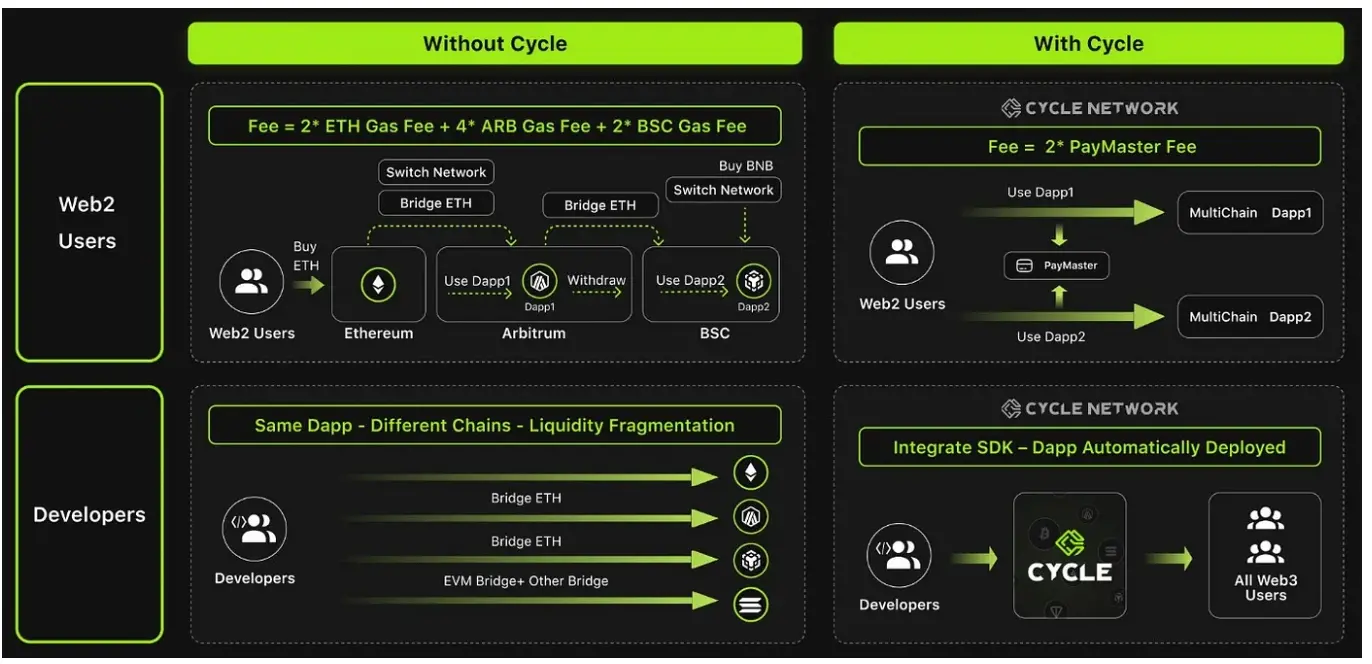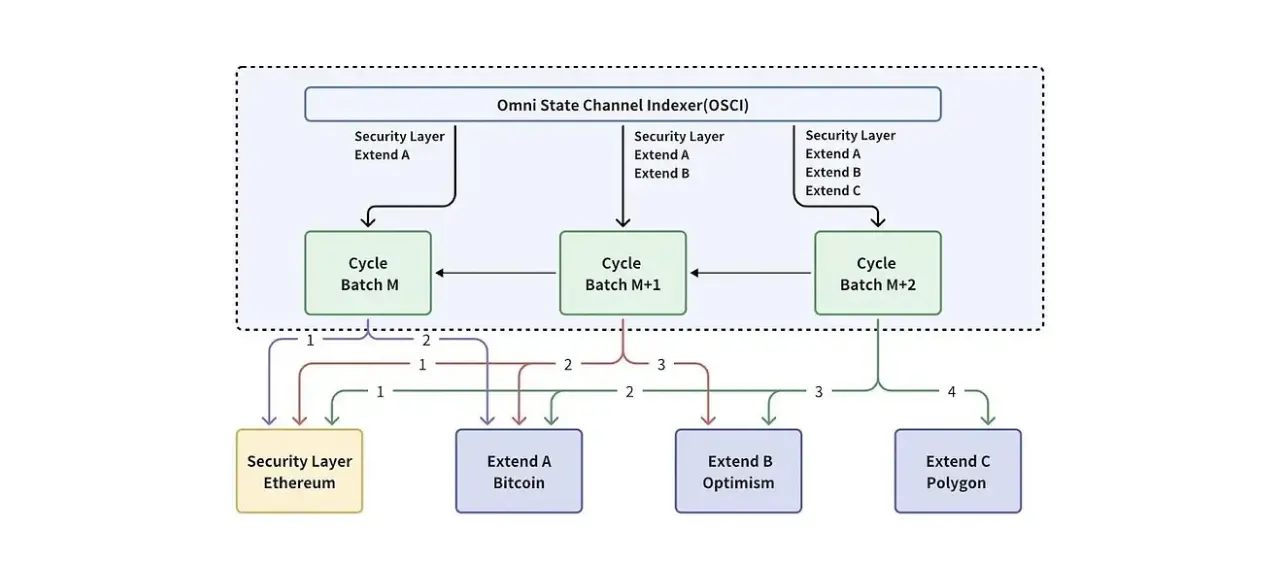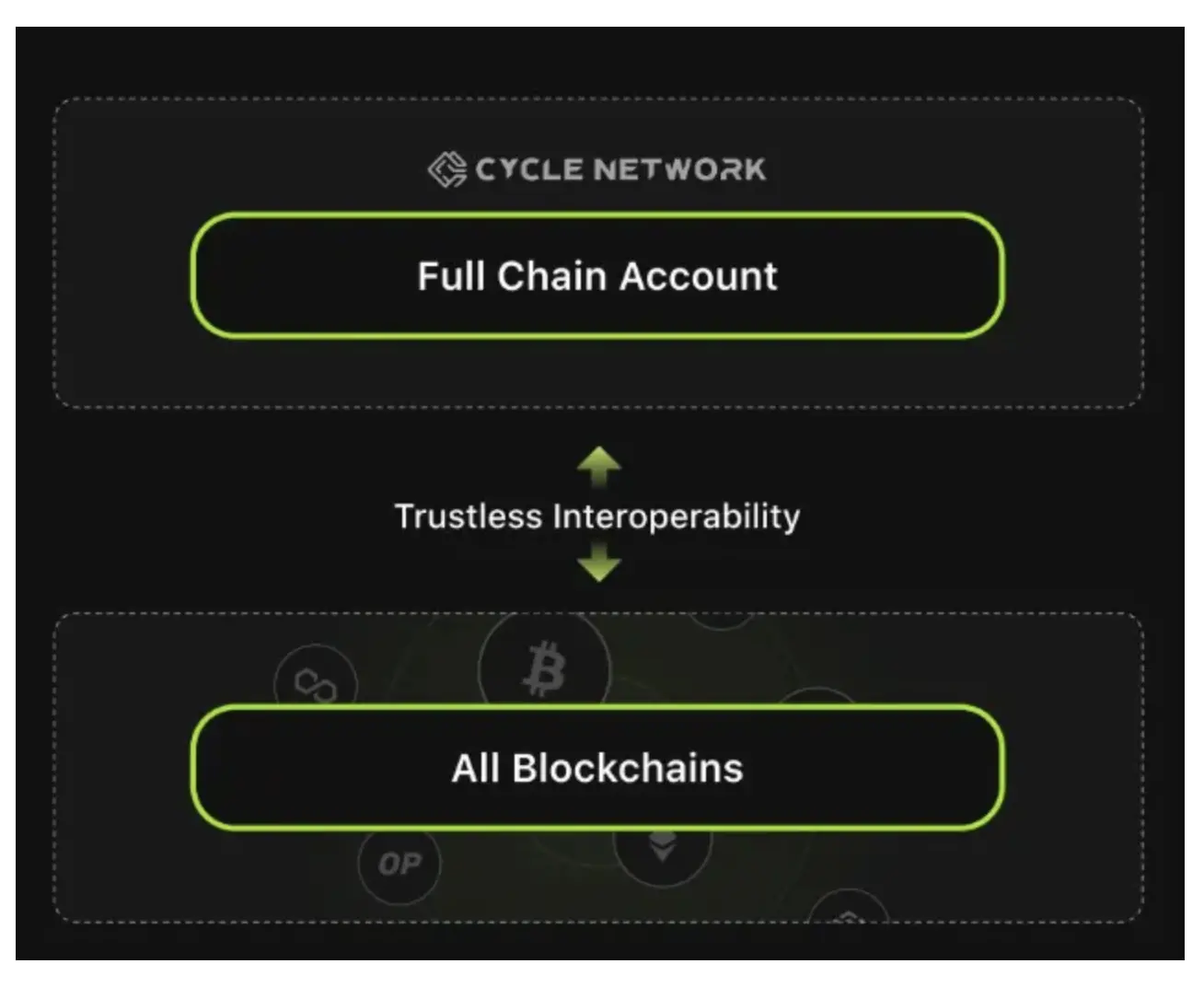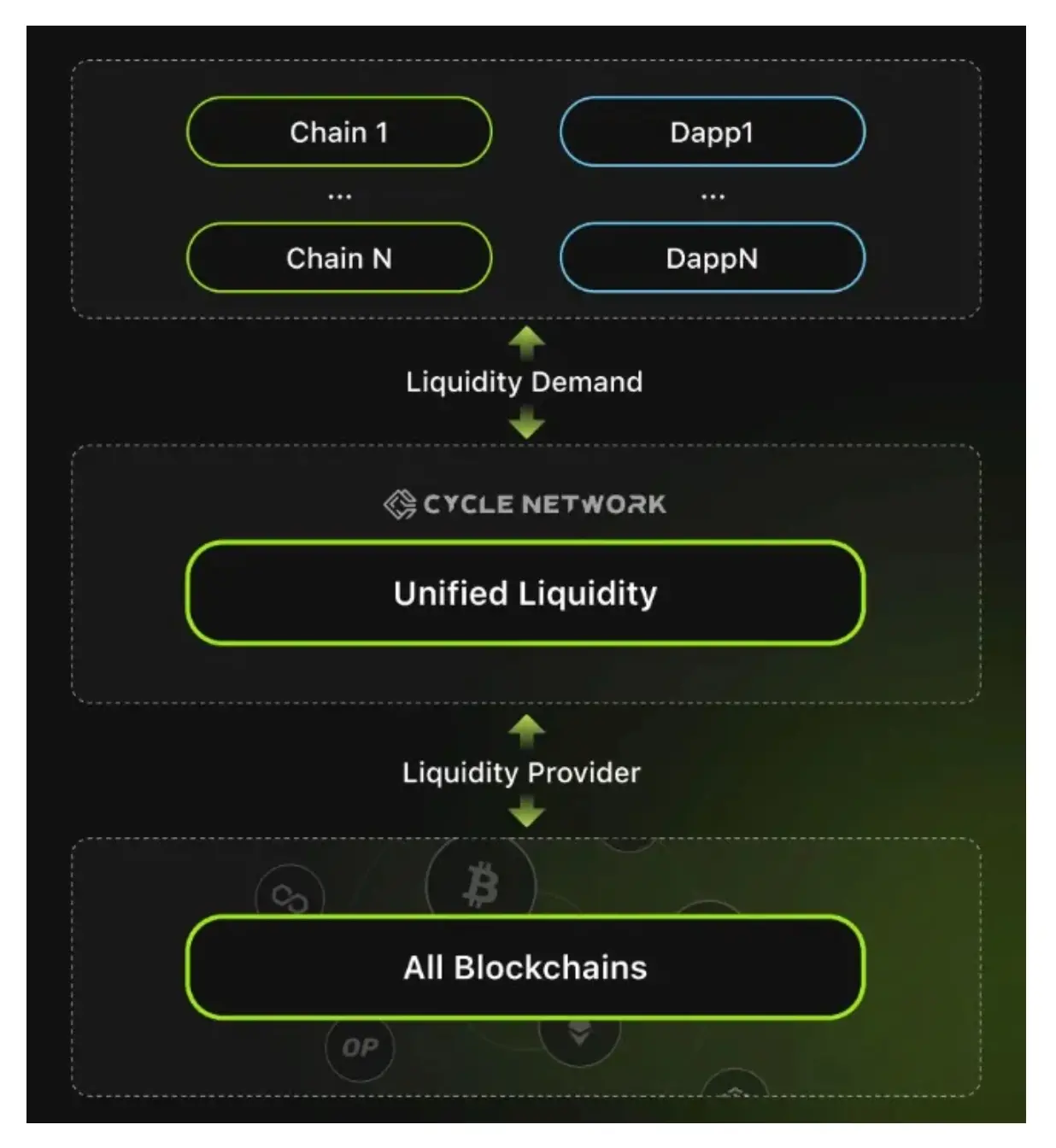How does Cycle Network build a full-chain liquidity aggregation network based on chain abstraction?
Background and Issues
Blockchain technology has long faced scalability issues. To address this, various Layer 1 and Rollup solutions have been proposed within the industry. With the implementation of these solutions, new public chains and Layer 2 Rollups have rapidly developed, expanding the performance scalability of blockchains, but they also face new situations: the state data of users and decentralized applications (DApps) is no longer limited to a few blockchains but is distributed across dozens of Layer 1 and Rollup networks.
This decentralization brings new challenges, including fragmented user experiences, increased barriers to entry, insufficient liquidity for decentralized finance (DeFi) protocols, the complexity of cross-chain DApp state synchronization, and increased governance difficulties. These issues require new solutions to cope with the increasingly complex blockchain ecosystem.
Solutions and Trends
With the evolution of blockchain technology and the improvement of infrastructure, three types of solutions/tracks have emerged in the market to address the above issues: cross-chain, omni-chain, and chain abstraction.
Cross-chain: Refers to interaction and communication between different blockchains to achieve interoperability of data and assets. Cross-chain technology allows applications and users on different blockchains to interact, breaking the blockchain island effect.
- Implementation: Achieved through cross-chain protocols, cross-chain bridges, or other technical means for inter-chain communication.
- Advantages: Enhances the interconnectivity and flexibility of blockchains, expanding application scenarios and ecosystems.
- Typical projects/applications: Cross-chain public chains represented by Polkadot and Cosmos; cross-chain bridge projects represented by Stargate, Hop Exchange, Across, and Synapse Bridge.
Omni-chain: Refers to achieving complete functionality and applications on a single blockchain, where all operations and data occur on this single blockchain.
- Implementation: Constructing a unified Layer that handles all operations and data on one blockchain without cross-chain interaction.
- Advantages: Simple system, high security, as all operations occur in a trusted environment.
- Typical projects/applications: Cross-chain messaging & asset protocols represented by LayerZero and Wormhole; Omni Network integrated with Rollup; cross-chain interoperability L1 public chain ZetaChain.
Chain abstraction: Refers to abstracting and encapsulating the complexity of blockchain systems, allowing developers and users not to deal directly with the underlying technical details. Through chain abstraction, developers can interact with different blockchains using unified interfaces and tools without worrying about the specific implementation details of each blockchain, while users can seamlessly browse and use Web3 applications without focusing on underlying blockchains, cross-chain operations, gas payments, and other complex details.
- Implementation: Providing unified interfaces through APIs, SDKs, or middleware, shielding the differences of underlying chains.
- Advantages: Improves development efficiency, enhances system flexibility and scalability; enhances user experience and adoption.
- Typical projects/applications: Trustless liquidity aggregation network Cycle Network; modular L1 public chain Particle Network.
Compared to the above three types of solutions, chain abstraction has significant advantages in developer-friendliness and user experience, making it a key driving force for the future development of blockchain and promoting mainstream adoption. Cycle Network is a leading project in the chain abstraction track, with its unique omni-chain communication technology providing distinct technical advantages in achieving asset liquidity aggregation and interoperability across different chains, bringing a more unified, convenient, and secure user experience to Web3.
What is Cycle Network?
Cycle Network is a trustless aggregated liquidity network for all blockchains, based on aggregated sequencers and chain abstraction. Cycle utilizes multi-chain zk-rollup technology to extend traditional one-to-one native bridges between L1 and L2 to support full connectivity across all chains. This enables users to achieve trustless omni-chain interoperability on Cycle.
Through Cycle Network, developers and users can experience seamless communication and value transfer across all chains, layers, and dApps.

Cycle Network is committed to liberating developers from repetitive and cumbersome tasks, providing a one-stop solution from underlying architecture to information/asset synchronization and deployment, allowing developers to focus on innovative exploration without fear of the unknown, fully tapping into the infinite potential of Web3.
What can Cycle Network do?
Cycle: Bridgeless cross-chain interoperability, easily build multi-chain applications
Cycle breaks down ecosystem barriers, achieving a seamless experience of cross-chain interoperability. Whether developers choose EVM chains, non-EVM chains, L2, or other modular chains, Cycle provides a one-stop solution that supports existing or new dApps to easily integrate and automatically build cross-chain applications. A simple plugin contract can enable cross-layer functionality without any code modifications or new chain deployments.
Omni-chain distributed ledger, empowering developers
Cycle provides an omni-chain distributed ledger, freeing developers from the hassle of cross-chain learning and deployment. No longer do they need to worry about complex consensus mechanisms or customized rule sets for each layer/blockchain. Cycle empowers developers to focus on developing innovative applications.
High speed, low cost, creating an ultimate experience
Cycle's toolkit, SDK, and advanced smart contract design enable developers to build efficient, low-cost multi-chain applications. Lightning-fast speed and an ultimate user experience will bring more value to your applications.
Core Technical Architecture
To achieve ultimate security and trustlessness, Cycle's cross-chain communication essentially deploys itself as a ZK-Rollup for all connected chains. The ZK-Rollup bridge provides trustless bidirectional verification. Cycle extends this functionality from Ethereum to all external networks, anchoring multi-chain states to Cycle states through aggregated sequencers. This simplifies the state synchronization issues in distributed systems, creating a decentralized super ledger and liquidity center for all blockchains.
It consists of three parts:
The overall architecture of Cycle Network mainly consists of three parts:
- Cycle Layer: The core layer of Cycle, providing unified multi-chain state management as a ZK-Rollup for the Security Layer and Extend Layer. Core modules include:
- Verifiable Aggregate Sequencer is the core module for packaging Cycle transactions, relying on the Omni State Channel Indexer (OSCI) deployed on Ethereum to package all transactions;
- Omni-Ledger is the global ledger on Cycle, storing all transaction states on Cycle Network, including cross-chain transactions and internal transactions of the Cycle Layer;
- Extend Layer: Connects other blockchains besides Ethereum, including all L2 and other heterogeneous L1s (such as Solana, TON, and Bitcoin). Core modules include:
- Bridging contracts used to lock native chain assets in Rollup contracts;
- ZK Verifier verifies the ZK proofs generated by Cycle, proving the legitimacy of the Rollup state;
- Extend DA provides data availability, ensuring the immutability and security of data.
- Security Layer: The security layer of Cycle, ensuring the security of transaction states, using Ethereum, the most secure programmable network. Core modules include:
- Omni State Channel Indexer (OSCI) is a decentralized multi-chain indexer that records the rules for Sequencer packaging multi-chain Rollin and Rollout transactions;
- The Security Layer, as a special Extend Layer, also has bridging contracts, ZK Verifier, and DA modules.

Key Component: OSCI
The key components of Cycle Network include the Omni State Channel Indexer and Verifiable State Aggregation. Based on these, Cycle Network can effectively aggregate liquidity from different networks and solve state synchronization challenges, relying on its key component, the Omni State Channel Indexer.
Omni State Channel Indexer
The Omni State Channel Indexer is a decentralized multi-chain indexer responsible for decentralized indexing and data availability across various extension layers in Cycle Network. It interacts with multiple blockchain networks (including Bitcoin, Ethereum, etc.), tracks assets and messages on different chains, and ensures that Cycle Network can verify and record data changes across different chains.

(Omni State Channel Indexer Diagram)
New Experiences and Use Cases of Cycle Network
New Experiences for Developers and Users
For Developers:
- Enhanced Interoperability: The global state of Cycle Network facilitates seamless interaction between different blockchain networks and creates an easy-to-use environment for developers to brainstorm and develop more functionally innovative dApps.
- Reduced Complexity: By using one-click deployment across all chains to solve multi-chain fragmentation issues, Cycle Network abstracts the development process and liberates developers from infrastructure centralization, allowing them to focus more on functional innovation.
- Increased Efficiency: Cycle Network provides dApps with toolkits to easily execute cross-chain communication and transactions, and through low latency and secure upgrades, the development process becomes smoother, resulting in a faster and more reliable experience.
For Users:
- Seamless Bridgeless Experience: Users can enjoy a better trading and interaction experience without the burden of chain notifications or liquidity and security fragmentation.
- Higher Accessibility: The integration of Cycle Network across multiple chains expands access to various decentralized applications and services, providing users with more choices and flexibility.
- Enhanced Security and Trust: Benefiting from trustless interoperability, users can enjoy enhanced security and reliability in transactions and data interactions across various blockchain networks.
Typical Use Cases of Cycle Network
Omni-chain Account: Unified Account Management
The omni-chain account solution aims to achieve seamless cross-chain interaction and unified account management. Through Cycle Network's connectivity across multiple blockchains, users can manage and operate cross-chain assets and transactions within a single account.

Liquidity Aggregator: Efficiently Allocate Liquidity
Cycle Network acts as a liquidity interface, collaborating with liquidity providers to aggregate and effectively allocate liquidity. dApps or chains can easily access liquidity through Cycle's Liquidity Faucet interface SDK. Even end users can act as liquidity providers, offering liquidity and earning LP rewards.

Multi-chain DeFi Ecosystem: Unlock More DeFi Legos
Cycle's plug-and-play compatibility will unlock more DeFi legos, activating more derivatives such as Perp Dex, LSD, options, interest swaps, etc., injecting new vitality into the DeFi ecosystem.
Omni-chain Trading Bots: Intelligent Trading, Higher Returns
Cycle supports omni-chain trading bots, multiplying the strategies of on-chain trading bots, achieving intelligent trading and bringing higher returns to users.
AI Agents: Omni-chain Data Empowerment, Intelligent Decision-making
Cycle provides real-time synchronization of omni-chain data, allowing AI agents to perform omni-chain machine learning, enhancing functionalities such as parameter tuning, treasury management, and DAO participation, helping developers build smarter and more powerful DeFi applications.
Omni-chain NFTs: Play to New Heights, Unlimited Excitement
Cycle supports omni-chain NFTs, and with more chain interactions, more exciting features will be experimented with on NFTs, such as displaying hidden functions/features/airdrops based on specific conditions/operations, bringing users a richer and more diverse NFT experience.
Omni-chain Dark Pools: Efficient Trading, Low Cost
Cycle supports omni-chain dark pools, helping large traders conduct large transactions with more diversified asset types, achieving low slippage, better prices, saving trading costs, and avoiding on-chain volatility, providing large traders with a more efficient and lower-cost trading experience.
Development Stages of Cycle Network
White Paper:
The first version of the Cycle Network white paper (v 0.5) has been officially released, sharing the detailed architecture and potential of how Cycle Network achieves global state, covering key topics including background, detailed technical disclosures of the Cycle Network framework, and potential practical applications that developers can deploy using Cycle Network.
White Paper URL: https://www.cyclenetwork.io/whitepaper.pdf
StarFish Testnet:
The Cycle Network Testnet 1.0, aimed at developers, "Starfish," has officially launched, introducing groundbreaking multi-chain aggregation features. Developers can program and build their own Omni dApps using the Cycle-JS-SDK.
Squid Testnet:
As the second iteration within Cycle Network, TestNet Squid has strategically integrated with the Bitcoin ecosystem, facilitating seamless transfers of BRC-20 assets into and out of Cycle Network. In addition to Ethereum's Layer 2 network, Cycle TestNet Squid has also integrated Bitlayer TestNet—Bitcoin's Layer 2 as an extension layer. It plans to integrate Bitcoin's native data availability infrastructure, Nbuit, into Cycle Network in the near future.
JellyFish Testnet:
JellyFish is the developer-focused Cycle Network Testnet 2.0, which has completed its official upgrade. Based on Starfish, it optimizes the bridge service, allowing developers to experience smoother Cycle SDK rollin & rollout services and build their own omni-chain products.
Piggybank:
Piggybank is a DeFi tool built on Cycle Network, designed to utilize aggregated liquidity to facilitate small transactions and savings services across various blockchains. Users can deposit small amounts of tokens left over from various transactions into Piggybank, which will intelligently route and exchange these tokens across multiple chains, enhancing the utility and efficiency of capital.
Team
The Cycle Network team consists of professors and experts from the University of Illinois, the University of California, Berkeley, Google, Baidu, Cobo, and the University of Bristol, with experience in cryptography, distributed ledger technology, ZK, cross-chain technology, marketing, and more.
Since 2017, the core team members of Cycle Network have been dedicated to the research and development of foundational blockchain technology, particularly in the fields of high-performance distributed ledgers and zk hardware acceleration, focusing on scalability and throughput. Their previous work has achieved remarkable results, with peak TPS reaching 56,000. The team has over 30 academic papers and more than 50 blockchain technology patents.
Driven by the initial goal of breaking through the boundaries of distributed ledger technology, the Cycle Network team was established to provide scalable and efficient solutions to meet the growing demands of the blockchain industry.
By leveraging rich web3 development experience and a deep understanding of developers' pain points, Cycle Network aims to allow web3 developers to focus on application-centered innovations, fully unleashing the potential of web3 blockchains.
Conclusion
As a leading project in the chain abstraction track, Cycle Network provides omni-chain asset liquidity infrastructure and solutions for public chains and applications through a three-layer architecture and verifiable state aggregation technology, offering a seamless, secure, and efficient mechanism to manage liquidity and transfer value across multiple blockchains, significantly enhancing liquidity integration and improving user on-chain interaction experiences. dApps integrated with Cycle's chain abstraction technology help users share omni-chain liquidity in a bridgeless manner, revolutionizing the fragmented experiences users face across different chains.










